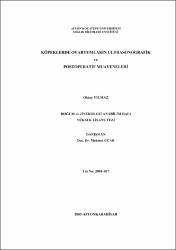Köpeklerde Ovaryumların Ultrasonografik ve Postoperatif Muayeneleri
Abstract
Bu çalışmada seksüel siklusun değişik dönemlerindeki köpeklerde,
ovaryumların ultrasonografi ile görüntülenmesi ve postoperatif muayenelerle
karşılaştırılması amaçlandı. Çeşitli ırklardan, 10-30 kg canlı ağırlığında, 25 adet disi
köpek kullanıldı. Vulva stenozu bulunan bir köpek dışında seksüel siklusların tespiti
için Giemsa boyamayla yapılan vaginal sitoloji kullanıldı. Ovaryumların yapıları ve
uzunlukları ultrasonografi ile görüntülendi. Elde edilen değerler postoperatif
ovaryum verileri ile karşılaştırılarak istatistiksel olarak değerlendirildi.
Köpeklerin (n:24) % 45.9’unun anöstrusta, % 25’inin proöstrusta, % 29.1’inin
diöstrusta olduğu belirlenirken, östrusta olan köpeğe rastlanmadı. Ultrasonografik
olarak sol ve sağ ovaryumlar sırasıyla % 96 ve 72 oranlarında, böbreğin kaudalinde,
hipoekoik yapıda görüntülenirken, her iki ovaryum % 84 oranında gözlendi. Ayrıca
proöstrus döneminde olan 3 köpekte anekojen ve içi sıvı dolu folliküller belirlendi.
Diöstrus döneminde olan bir hayvanda 5 adet, lobuler tarzda luteal yapılar izlendi.
Diöstrusta olan başka bir köpekte ise ovaryumun kaudalinde, anekoik görüntü veren
kistik bir olusum tespit edildi. Her iki ovaryumun ultrasonografik muayenesi 3-30
dakika arasında gerçekleştirildi.
Ultrasonografik ve postoperatif muayenelerde ovaryumlar ortalama olarak
sırasıyla solda 1.32±0.28 ile 1.43±0.22 cm (p<0.05, r: 0.473) ve sagda 1.39±0.32 ile
1.40±0.20 cm (p<0.01, r: 0.758) tespit edildi. Ayrıca ultrasonografi ile belirlenen
ovaryum uzunluk ölçüleri ile canlı ağırlık ortalaması 14.44±2.83 ve 22.69±3.88 kg
olan köpekler karşılaştırıldığında, her iki canlı ağırlık ortalaması arasında istatistiksel
açıdan fark olduğu gözlendi (p<0.05). Bunun yanı sıra sol ile sağ ovaryumların ağırlık
ve hacimleri sırasıyla ortalama olarak 0.71±0.28 ile 0.66±0.26 g ve 0.71±0.30 ile
0.60±0.26 cm³ arasında bulunurken, hayvanların canlı ağırlıkları ile ovaryumların
ağırlık ve hacimleri arasında istatistiksel anlamda fark belirlenemedi.
Ultrasonografik muayenelerde köpeklerin sahip olduğu seksüel siklus
dönemlerinde elde edilen ovaryum ölçümleri karşılaştırıldığında, proöstrus
dönemindeki köpekler ile anöstrus ve diöstrus dönemindeki köpekler arasında fark
bulunmasına rağmen istatistiksel açıdan önemli bulunmadı.
Sonuç olarak, kasektik hayvanların ultrasonografik muayenelerinde, sağ
ovaryumların görüntülenmesinin sol ovaryumlara göre güç olduğu belirlenirken, canlı
ağırlık ile ovaryum uzunluğu arasında pozitif bir ilişki bulundu. Ayrıca ovaryumların
fizyolojik ve patolojik yapılarının tanısında, ovaryum kökenli infertilite
problemlerinin yorumlanmasında ultrasonografinin kullanılabileceği, bununla birlikte
muayenelerin periyodik olarak yapılmasının daha faydalı olabileceği
düşünülmektedir. Ultrasonographic monitoring of the ovaries and its correlation with the
postoperative measurements were investigated in 25 bitches, weighing between
10-30 kg, at various phases of sexual cycle and from different breeds. The vaginal
cytological staining by Giemsa was used to determine the phases of oestrus cycles,
excluding one dog due to vulvar stenozis. Then the ovaries were visualized and
measured by ultrasonography. These data were compared with the structures and the
lengths of ovaries obtained after surgical removal and analyzed statistically.
The percentage of animals (n:24) in anoestrus, prooestrus or dioestrus was
45.9, 25.0, 29.1 %, respectively, but oestrus phase was not observed in any bitches.
Ultrasonographically, the left and right ovaries were detected at the caudal side of the
kidneys as hypoechoic structures and monitored in 96.0 and 72.0 %, respectively
and both were observed in 84.0 %. Furthermore anechoic and fluid-filled follicles
were detected in 3 prooestrus bitches. In an animal in dioestrus, 5 luteal structures
were observed. A cyst formation localized at the caudal part of the ovary was
determined as an anechoic structure in another animal in dioestrus. The
ultrasonographic examination of each ovary was carried out within 3 to 30 minutes.
The average diameter of the ovaries detected by ultrasonography and after
surgical removal were 1.32±0.28, 1.43±0.22 cm in the left ones (p<0.05, r: 0.473)
and 1.39±0.32, 1.40±0.20 cm in the right ones (p<0.01, r: 0.758), respectively.
Furthermore, when the weight of animals and ultrasonographic ovarian
measurement data compared, a statistically significant difference was seen between
the bitches weighing 14.4±2.83 and 22.69±3.88 kg (p<0.05). There was no
significant difference between the weight of animals and the average volumes and
weight of the left and right ovaries defined as 0.71±0.28 and 0.66±0.26 g, 0.71±0.30
and 0.60±0.26 cm³, respectively, by postoperative measurements.
XIII
XV
When the lengths of ovaries obtained from ultrasonographic examinations in
different sexual cycle phases of the bitches compared to each other, there was a
difference between the bitches in prooestrus and the animals in anoestrus and
dioestrus, but this was not statistically significant.
In conclusion, ultrasonographic examinations showed that imaging of the right
ovaries was more difficult than the left ovaries due to cachexia. There was a positive
correlation between body weight and the length of ovary. Also this study suggests
the use of ultrasonography in the diagnosis for the physiological and pathological
ovarian functions in the bitches providing basis for the successful interpretation
about infertility problems originating from the ovary, however, periodic
examinations should be performed.
Collections
- Yüksek Lisans Tezleri [636]



















